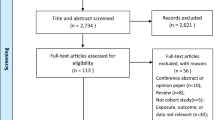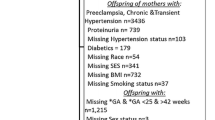Abstract
Purpose
Macedonia is one of the top five countries globally in reported smoking rates. Over 10 % of the population consists of the underprivileged Roma minority. We aimed to determine whether Roma ethnicity is an independent risk factor for adverse pregnancy outcome or merely mediating maternal smoking.
Methods
Maternal data were retrieved from the perinatal computerized database for all deliveries during 2007–2011 at the only Clinical Hospital in Bitola, Macedonia. Multivariable regression models were constructed to control for confounders.
Results
Of nearly 7,000 deliveries, 8.65 % were of maternal Roma ethnicity and 40 % of the Romani women admitted to regularly smoke during pregnancy. Both Roma ethnicity and maternal smoking were significantly associated with the absence of maternal education, history of abortions and intra uterine growth restriction (IUGR) in the univariate analysis. Both maternal Roma ethnicity (OR 2.46, 95 % CI 1.79–3.38) and smoking status (OR 1.37, 95 % CI 1.02–1.85) were found to be independent predictors of IUGR using the multivariate analysis. Lower birthweight and smaller head circumference were both independently associated with Roma ethnicity and smoking.
Conclusions
Underprivileged ethnic background is a significant risk factor for IUGR, independent of maternal smoking status. To the best of our knowledge, this is the first publication focusing on pregnancy outcome in Romani Macedonian parturients.
Similar content being viewed by others
References
Ananth CV, Cnattingius S (2007) Influence of maternal smoking on placental abruption in successive pregnancies: a population-based prospective cohort study in Sweden. Am J Epidemiol 166:289–295
Roelands J, Jamison MG, Lyerly AD, James AH (2009) Consequences of smoking during pregnancy on maternal health. J Womens Health (Larchmt) 18:867–872
Mehaffey K, Higginson A, Cowan J, Osborne GM, Arbour LT (2010) Maternal smoking at first prenatal visit as a marker of risk for adverse pregnancy outcomes in the Qikiqtaaluk (Baffin) Region. Rural Remote Health 10:1484
Shi M, Wehby GL, Murray JC (2008) Review on genetic variants and maternal smoking in the etiology of oral clefts and other birth defects. Birth Defects Res C Embryo Today 84:16–29
Tong VT, Jones JR, Dietz PM, D’Angelo D, Bombard JM (2009) Trends in smoking before, during, and after pregnancy—pregnancy risk assessment monitoring system (PRAMS), United States, 31 sites, 2000–2005. MMWR Surveill Summ 58:1–29
Kafouri S, Leonard G, Perron M et al (2009) Maternal cigarette smoking during pregnancy and cognitive performance in adolescence. Int J Epidemiol 38:158–172
Cornelius MD, Day NL (2009) Developmental consequences of prenatal tobacco exposure. Curr Opin Neurol 22:121–125
Martin JA, Hamilton BE, Sutton PD, Ventura SJ, Menacker F, Munson ML (2005) Births: final data for 2003. Natl Vital Stat Rep 54:1–116
Connor SK, McIntyre L (1999) The sociodemographic predictors of smoking cessation among pregnant women in Canada. Can J Public Health 90:352–355
FYR_Macedonia.pdf (internet) (2012) http://www.who.int/tobacco/media/en/FYR_Macedonia.pdf. Accessed 23 May 2012
Pavlovska I, Orovchanec N, Stefanovski T, Zafirova-Ivanovska B (2009) Tobacco use and the risk of lung cancer in Macedonia. Bratisl Lek Listy 110:319–323
Are we effectively controlling tobacco? A look at the industry’s data | Global Health Hub: news and blogosphere aggregator (Internet) (2012) http://www.globalhealthhub.org/2011/11/16/tobaccosales. Accessed 7 June 2012
Kosevska E, Polozani A, Spasovski M, Kishman Hristovska M, Petlichkovska S (2009) Global youth tobacco use prevalence and exposure to environmental tobacco smoke in the Republic of Macedonia. Maced J Med Sci 2:245–254
Jovanovska T, Prodanovska-Stojcevska V (2011) The attitudes of students—future health professionals regarding tobacco usage. Maced J Med Sci 4:196–200
Onceva S, Donev D, Gligorov I (2001) Tobacco smoking, alcohol and drug consumption among youngsters in the Republic of Macedonia. Med Arh 55:27–28
Hajioff S, McKee M (2000) The health of the Roma people: a review of the published literature. J Epidemiol Community Health 54:864–869
Semerdjieva M, Mateva N, Dimitrov I (1998) Sexual culture of gypsy population. Folia Med (Plovdiv) 40:72–75
Dejmek J, Selevan SG, Sram RJ (1996) The environment, life style and pregnancy outcome. Cas Lek Ces 135:510–515
Joubert K (1991) Size at birth and some sociodemographic factors in gypsies in Hungary. J Biosoc Sci 23:39–47
Bernasovska K, Bernasovsky I, Poradovsky K, Vargova T (1977) Anthropology of maternity. Proposal of low birth-weight limit for gypsy mature babies. Charles University, Prague, pp 173–175
Seres I (1998) Specific issues in gypsy population prenatal care. Slovenska Gynekologia Porod 5:125–131
Rimarova K, Ostro A, Bernasovska K, Holecyova G (2004) Reproductive indicators of Roma mothers: cross-sectional study. In: Aghova L (ed) Living conditions and health. Public Health Office of the Slovak Republic, Bratislava, pp 110–114
Bobak M, Dejmek J, Solansky I, Sram RJ (2005) Unfavorable birth outcomes of the Roma women in the Czech Republic and the potential explanations: a population-based study. BMC Public Health 5:106
Abu-Ghanem S, Sheiner E, Sherf M, Wiznitzer A, Sergienko R, Shoham-Vardi I (2012) Lack of prenatal care in a traditional community: trends and perinatal outcomes. Arch Gynecol Obstet 285:1237–1242
Shen JJ, Tymkow C, MacMullen N (2005) Disparities in maternal outcomes among four ethnic populations. Ethn Dis 15:492–497
The Organization for Security and Cooperation of Europe (OSCE) (2000) Report on the Situation of Roma and Sinti in the OSCE Area. OSCE, High Commissioner on National Minorities, The Hague
Puporka L, Zadori Z (1999) The health status of Romas in Hungary. World Bank Regional Office, Hungary. NGO Studies No. 2. http://www-wds.worldbank.org/servlet/WDSContentServer/WDSP/IB/2001/12/11/000094946_01110704112038/Rendered/PDF/multi0page.pdf
Bernis C, Varea C, Bogin B, González-González A (2012) Labor management and mode of delivery among migrant and Spanish women: does the variability reflect differences in obstetric decisions according to ethnic origin? Matern Child Health J (Epub ahead of print)
Conflict of interest
The authors report no conflict of interests. This study was not funded. The authors state they have had full control of all primary data and that they agree to allow the Journal to review their data if requested.
Author information
Authors and Affiliations
Corresponding author
Rights and permissions
About this article
Cite this article
Walfisch, A., Nikolovski, S., Talevska, B. et al. Fetal growth restriction and maternal smoking in the Macedonian Roma population: a causality dilemma. Arch Gynecol Obstet 287, 1131–1136 (2013). https://doi.org/10.1007/s00404-013-2731-1
Received:
Accepted:
Published:
Issue Date:
DOI: https://doi.org/10.1007/s00404-013-2731-1




